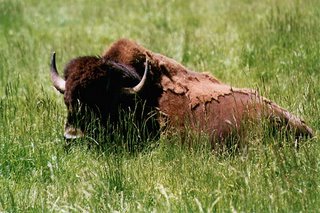
- 3 cans of beans (kidney, pinto, red or black), drained and rinsed in a collander
- 24 oz of crushed strained tomatoes (Pomi makes a great product)
- 1-2 cans of Rotel diced tomato with chiles, drained
- 1 lb of ground grass-fed/hormone-free buffalo (or lean ground beef), browned
- 3 cloves of garlic, minced
- Fresh cilantro (to taste)
- 1 packet of Goya Sazón with Coriander and Annatto
- 1 tsp chili powder
Mix all ingredients in a pot and simmer on medium-low heat for 30-40 minutes. Do not allow the chili to boil. The slow simmer will allow the chili to develop its own rich gravy.
Health notes: Rinsing the beans and draining the Rotel eliminates most of the salt from these canned products. I highly recommend using buffalo: buffalo meat has more flavor and less fat than beef, and grass-fed buffalo is higher in Omega-3 fatty acids and iron than beef (and without the risk of BSE that exists with industrially-raised beef).
Namaste, and bon appetit!

